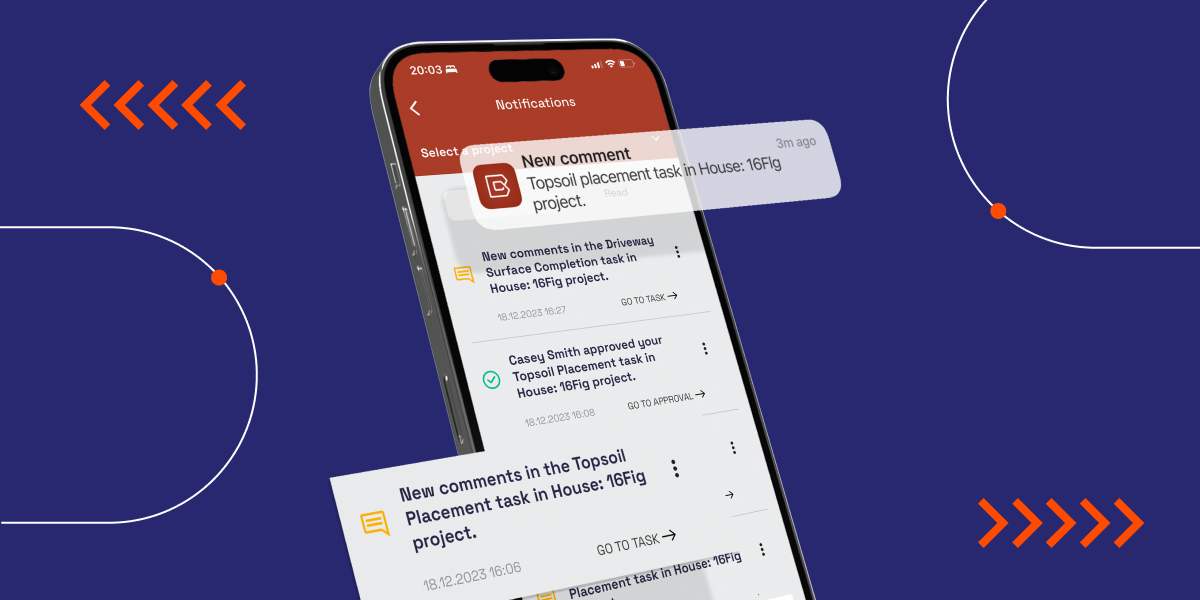Has the definition of effective communication on a job site changed in recent years? How would you describe good communication today?
If you’re like most construction project managers, you’d agree that remote, asynchronous collaboration has become one of the most significant shifts.
On the one hand, it allows you to manage multiple work sites and stay productive. On the other hand, even with all the communication tools available today, construction projects still need to be more cohesive. Rework accounts for 52% of lost productivity, amounting to a staggering $280 billion globally, and productivity continues declining.
In my experience, many of these problems come down to poor communication. Yes, the industry is more collaborative than ever, but it’s not without its challenges. You’re not just managing different personalities on the job site (owners, architects, supervisors, foremen, subcontractors) but also navigating communication across the four stages of the construction process. Ultimately, poor communication leads to poor collaboration, which drives operational issues.
To help, I will give you 8 practical tips to improve communication on the job site. But first, let’s establish what effective communication is today and explore the factors that might be holding you back from achieving it.
Below is a quick-navigation of the 8 tips for effective communication on the job site:
- Learn leadership and management communication skills
- Manage all project documents in one place
- Prevent information overload with controlled file sharing
- Prevent safety silence with two-way communication
- Use visual communication aids on-site
- Conduct regular briefings and toolbox talks
- Adopt mobile communication tools
- Implement user-friendly digital tools
What is effective communication on a construction site?
Effective communication on a construction site ensures that everyone, from workers to supervisors, subcontractors, and project managers, gets the correct information at the right time in a format that is easy to understand and act upon, ultimately driving a productive outcome.
Construction, as we know, isn't a linear process. It's cyclical. The complexity of moving through different phases—design, planning, building, and operations—means that multiple teams need to be in sync, but often, that doesn't happen.
People use different tools: emails, WhatsApp, physical plans, phone calls, or handwritten notes. These mismatched methods create disconnection, causing delays and confusion between phases and teams. It's easy to see how information gets lost in translation when everyone communicates in their preferred way.
Because of these challenges, effective communication on a construction site should be:
- Clear—everyone knows exactly what to do.
- Concise—there's no room for fluff; instructions are direct.
- Actionable—people know the next steps.
- Relevant—what’s being communicated matters to the task at hand.
- Timely—it arrives when it’s needed.
More so, good communication isn’t just about spoken words. Tone, gestures, and even how you deliver the message matter; more on this later. It’s not one-way either, feedback and clarification are key to ensuring everyone is aligned.
When communication works like this, a connected job site emerges. You’ll experience a level of connectivity that brings new opportunities:
- Increased productivity
- Improved efficiency
- Seamless collaboration.
Now, teams are not just working together, they’re thriving. Information flows freely, people know what’s happening, and the project moves forward without a hitch.
When that connection breaks down, though, everything suffers:
- Key information gets missed
- Deadlines slip
- Rework happens because changes weren’t communicated in time
- Worse, you’re working off outdated plans without realizing it
These are just a few benefits of maintaining effective communication on the job site. However, achieving this level of connectivity comes with its challenges, and understanding them is critical to overcoming them.
Why is communication so challenging on construction projects?
Communication on construction projects is uniquely tricky due to the complex, fast-paced nature of the work. Keeping everyone aligned and informed on a project is a constant challenge, with so many moving parts and stakeholders involved.
Here are some common barriers to communication in construction.
- Constantly shifting priorities: Construction projects are fluid, with frequent changes in plans, deadlines, and materials. As priorities shift, communicating these updates to the entire team promptly and clearly can be difficult, especially when multiple teams are involved.
- Large and fragmented teams: On most job sites, you’ll find multiple teams working on different tasks simultaneously, often spread across different site areas. This geographical separation makes delivering messages directly and consistently across all levels harder, increasing the likelihood of miscommunication.
- Safety silence: This occurs when workers or team members withhold information about potential safety risks or hazards because they fear consequences like a reprimand, slowing down the project, or damaging their reputation.
- Time-sensitive work environment: Deadlines are tight, and there’s always pressure to keep the project on schedule. This can lead to rushed communication where clarity and detail are sacrificed for speed, resulting in mistakes and confusion.
- Noise and environmental disruptions: Job sites are noisy, with machinery, tools, and activity often drowning out verbal instructions. This physical environment can hinder real-time communication, especially when relying on traditional methods like shouting instructions or using hand signals.
Lack of feedback loops: In many cases, communication on the job site is one-way, project managers give instructions, but workers cannot clarify or provide feedback. This lack of a feedback loop means that misunderstandings often go unaddressed until it’s too late.
8 tips for good communication on the job site
Good communication on the job site is essential for maintaining safety, productivity, and meeting deadlines. Here are 8 practical tips for project managers to enhance communication across all levels of a construction project:
1. Learn leadership and management communication skills
As a construction project manager, effective communication isn’t just about sending emails or giving instructions. It’s a balancing act between management and leadership communication skills. You use management communication tools to handle processes, tasks, and logistics. Leadership communication, on the other hand, is how you guide, motivate, and influence people.
Why is this so important? As we’ve already established, effective communication is relevant, timely, and outcome-driven. It’s not just about what you say but how and when you say it.
For example, assigning tasks in your project management software is a managerial function; clear, concise, and action-oriented. Are you motivating your team to push through a challenging phase or resolving conflict? That’s leadership. And you need the two skills to succeed.
Leadership communication tools include in-person conversations, phone calls, and video meetings. These are best used for:
- Addressing conflict or delivering difficult information
- Sharing time-sensitive or critical updates
- Providing feedback, especially constructive feedback
- Motivating the team, driving action, or building trust
- Handling urgent or high-stakes situations
Leadership communication becomes your most powerful tool when you need to inspire action, build influence, or foster trust. Think about that one difficult conversation you’ve had where body language, tone, and even the setting played as much of a role as the words you used.
Maybe you had to pull a subcontractor aside to discuss safety violations or motivate the crew to finish a task on time after unexpected delays. That’s where leadership communication excels.
On the other hand, management communication tools are essential for tasks that are more process-driven. These include emails, PM (Project Management) software updates, and text messages. They work best for:
- Sending routine information or updates
- Urgent follow-ups, meeting minutes, task tracking, or documentation
- RFIs (Request for Information) that clarify issues
- Managing changes to plans or specs
- Items that need review, like submittals or contract details
Mastering both leadership and management communication ensures that you not only keep your project on track but also build a stronger, more connected team. Knowing when to lead and when to manage through communication could be the difference between just getting the job done and truly driving results.
2. Manage all project documents in one place
Document management is central to everything you do on a construction site. From design to operation, every phase depends on accurate, up-to-date documentation. And because construction isn’t a linear process, you often need to revisit and revise documents. For a project to succeed and achieve operational efficiency, all of these documents must stay tightly connected. Unfortunately, many construction sites today still face significant disconnects.
You would be surprised by how many sites still process handwritten work orders. One wrong entry or a delayed update, and communication quickly breaks down.
Take change orders, for example. Contracts today are often written early to lock in material prices and budgets, even while the design continues to evolve. This leads to frequent changes, making the change order process increasingly complex. Tracking these changes through long email chains or spreadsheets used to be the norm, but that approach often caused inefficiencies and confusion.
This is where construction project management software makes a difference. It eliminates the problem of fragmented, siloed documents by creating a seamless, connected platform. With real-time collaboration tools like PDF annotations and instant messaging, everyone stays on the same page, even if they’re using different internal systems. These systems allow you to manage field execution and project oversight efficiently, keeping things on schedule and within budget.
That doesn’t mean construction PM software is a magic fix for every issue. There will always be surprises, maybe you found an unexpected gas line or hit something unknown underground. The key is making sure the process for communicating and handling changes is as smooth as possible.
Confidence is everything here: confidence that your teams are working with the correct information; that the project will be completed with minimal rework, and confidence that your clients trust you to deliver on time and on budget.
3. Prevent information overload with controlled file sharing
In construction, timing is everything. It’s not just about delivering the right information; it’s about delivering it to the right people at the right time. That’s where controlled file sharing comes in.
When everyone on the job site has access to every piece of information, whether they need it or not, you end up with information overload. The more unnecessary data someone has to sift through, the longer it takes for them to act, leading to delayed execution and, ultimately, lost productivity.
To prevent this, you need to control who gets what information and when they receive it. A good construction management software with controlled file-sharing features can help you do just that.
It allows you to assign specific documents to specific roles, tasks, or phases, ensuring that only relevant people, whether it’s your foreman, subcontractor, or supervisor, see the information they need when they need it. This keeps the focus sharp and execution fast, avoiding the pitfalls of overwhelming everyone with details they don’t need.

If you’re not using a construction management platform with controlled sharing, there are still steps you can take to limit information overload:
- Avoid using emails and WhatsApp to communicate with clients and team members. WhatsApp and email are helpful, but they're just not made for managing construction communication. Information is overwhelming and disorganized in WhatsApp. Email often gets ignored or, worse, lost in the junk folder.
- Use phone calls for urgent or easily lost messages: When something needs immediate attention, don’t rely on email, where notifications might be missed. A quick phone call can ensure important updates are received and acknowledged in real-time.
- Establish clear communication channels: Use specific communication channels for different teams or project phases. For example, your design team should communicate separately from the build team, limiting cross-over unless absolutely necessary.
- Set permissions on shared drives: If you’re using cloud storage or a shared drive, set permissions so that only the necessary people can view or edit certain files. This helps prevent accidental changes or information leaks.
- Break information into digestible chunks: Instead of sharing entire project folders, break down files into smaller, relevant segments. This way, team members only receive what pertains to them.
This way, you’ll keep communication streamlined, avoid confusion, and allow your project to move forward efficiently.
4. Prevent safety silence with two-way communication
While two-way communication is critical across all facets of a construction project, it’s absolutely vital when it comes to safety. Safety silence, when workers or team members fail to speak up about potential hazards or unsafe conditions, is one of the most dangerous outcomes of poor communication on a job site. This is one of the reasons construction is the most dangerous industry.
The biggest factor driving safety silence is poor communication. This often stems from a lack of channels where workers feel empowered to voice concerns, confusion about what’s expected of them, or even fear of speaking up about dangerous practices. When workers don’t feel like their concerns will be heard, or, worse, fear retaliation, they stay silent. And silence on a construction site is never safe.
This issue is even more critical when dealing with contract workers. Contract workers, such as electrical or mechanical contractors, or vendors hired for short or long-term assignments, often perform tasks that are infrequent, complex, or hazardous.
Therefore, these workers might be handling equipment or materials unfamiliar to the host employer. If full-time workers aren’t empowered to report safety issues and project managers or supervisors fail to address them, serious hazards can arise.
The leadership communication skills I talked about earlier play a huge role here. You have to build trust and establish an environment where people know their input matters and that safety is everyone's responsibility, not just management’s.
How to establish two-way communication on safety
Here are some practical techniques and tools you can use to establish two-way communication on safety:
- Hold regular safety check-ins: Schedule briefs and daily safety check-ins where workers are encouraged to report any concerns or observations. Make these meetings collaborative—allow workers to share their insights, and act on those inputs quickly.
- Use anonymous reporting systems: Not every worker will feel comfortable speaking up in front of a group or even directly to a manager. An anonymous reporting tool (via an app or a suggestion box) can help encourage workers to report safety concerns without fear of reprisal.
- Use a tool that allows workers to promote safety: A tool like Buildbite integrates and facilitates two-way communication. It enables workers to log issues on tasks and phases, report hazards to the team, and receive real-time updates on resolutions.
- Encourage real-time feedback: Create an open-door policy where workers can approach you or other supervisors to raise concerns at any time, not just during scheduled meetings. This can be supported with a mobile-first communication platform so that workers on-site can easily provide feedback while in the field.
- Lead by example: Show your team that you’re listening. Act on their concerns quickly, address reported safety issues without delay, and recognize workers who prioritize safety. This reinforces that their voice matters, building the confidence they need to speak up.
- Set up a feedback loop: Create an ongoing feedback mechanism so that team members can report problems or suggestions. This could be a suggestion box, regular check-ins, or feedback forms after project milestones.
Implementing these practices helps you foster an environment where two-way communication is the norm, not the exception, especially when it comes to safety. It is a proactive approach that ensures your team feels heard, connected, and, most importantly, safe.
[Download now: step-by-step guide on how to conquer big challenges in construction]
5. Use visual communication aids on-site
For complex instructions or updates, use visual aids like diagrams, project plans, or infographics. Visual communication can simplify difficult concepts and ensure that everyone understands the message.
Additionally, provide multilingual support and visual communication aids (such as diagrams or color-coded instructions). This is critical for when you’re working with temporary workers who aren’t quite familiar with the environment.
6. Conduct regular briefings and toolbox talks
Hold daily or weekly briefings with all teams to ensure everyone is on the same page. Toolbox talks should emphasize safety protocols and any updates on project developments.
7. Adopt mobile communication tools
Mobile communication tools help streamline real-time communication between all members of a construction team, from on-site workers to project managers, no matter where they are. They enable instant messaging, voice or video calls, file sharing, and access to project management systems directly from mobile devices.
Common mobile communication tools used on construction sites
- Field management apps - Enable real-time communication between field workers, project managers, and office teams.
- Digital radios or Walkie-Talkie apps – Hands-free communication similar to traditional two-way radios.
- Project management software – Provide access to project documents, blueprints, and schedules while facilitating communication between office and field workers.
- Video conferencing apps – For virtual meetings with remote teams or contractors.
- Task management apps – Helps track progress, assign tasks, and follow up on deadlines while providing real-time updates.
- Safety reporting apps – Allow workers to report hazards or safety concerns immediately from the field.
- Noise-canceling headphones – Allow workers to communicate clearly regardless of environmental conditions.
How construction communication software helps on the job site
Instead of disjointed or overwhelming WhatsApp messages that get lost in the mix, construction communication software provides a real-time communication medium where updates, instructions, or safety alerts are instantly delivered and structured, no matter where workers are on the site. Here’s how that might help improve communication on the job site:
Prevents inconsistent messaging across teams (office and site):
Construction projects often involve multiple subcontractors and teams working simultaneously. If teams receive conflicting instructions, confusion and delays are inevitable, leading to inefficiencies or safety hazards.
Construction communication software helps by standardizing communication protocols and making sure the instructions are stored in the right place. It creates a single source of truth where all instructions and updates are recorded, reducing the risk of miscommunication and ensuring that every team member is aligned.
Ensures emergency issues are captured with push notifications for urgent updates:
In the event of emergencies or urgent project changes, push notifications provide an immediate alert system to ensure critical updates are seen and acted upon promptly. This feature cuts through regular communication traffic and guarantees that urgent information is disseminated rapidly to everyone who needs it.
In Buildbite, critical updates, such as exceeding budgets or time limits, will automatically trigger notifications to ensure you're always in the loop.

Breaks down language barriers:
If your team is multilingual, communication software like Buildbite offers language options, enabling you to translate key safety information or instructions in real-time. This eliminates potential misunderstandings and ensures that all workers, regardless of language, are on the same page.
Simplifies and clarifies instructions with a tiered communication approach:
When delivering instructions, it’s crucial that they are clear, concise, and actionable. Construction communication software allows you to break down information into relevant updates for specific teams and tasks, ensuring that only essential information is communicated during task briefings. Buildbite’s group correspondence feature helps streamline updates, avoiding information overload while keeping each team focused on their tasks.
[Add product snapshot - segmented communication]
Distinguish your communication between internal and external channels
With a feature like multi-chat in Buildbite, you’ll be able to segment your communication into different groups for relevant team members and clients. What sets Buildbite apart from basic messaging tools like WhatsApp is its structured communication, all within the same platform where you can organize projects, assign tasks, manage teams, track time, compile reports, and more—all in one place. Less switching between apps means less chance of losing important information!
Maintains consistent communication between office and field teams:
When project managers must manage multiple sites remotely, construction communication software enables regular communication between office and field teams. Progress, changes, and challenges are updated consistently, and transparently, preventing misalignment and ensuring everyone is working towards the same goals.

Develops a culture of transparency:
Transparency fosters trust and collaboration on the job site. Construction communication software empowers project managers to set the tone by openly sharing progress, updates, and potential challenges. Regularly structured progress reports keep everyone informed about the project’s status, manage expectations, and ensure the entire team stays aligned with common goals.
8. Implement user-friendly digital tools
Digital tools have become a mainstay in construction. And while the industry increasingly embraces digital transformation, with 58% having a digital strategy in place, the lack of a designated person to drive the strategy (34%) is a significant barrier.
Many digital software products in construction are overly complex, with steep learning curves that require specialists. This slows adoption and increases costs, diverting valuable resources. Every day spent struggling with these tools is a missed opportunity for your team to focus on communication and task management using an easier, more efficient alternative.
For example, with Buildbite, our intuitive, mobile-first field management app, you can effortlessly:
- Oversee multiple construction projects with a clear, centralized view
- Break projects down into phases and tasks for better organization
- Assign tasks to subcontractors or workers with precise instructions
- Communicate and collaborate with workers and subcontractors, free from distractions
- Track task progress instantly with built-in time tracking
- Invite clients for full transparency and real-time updates
- Generate custom reports tailored to your needs
...and all of this without the need for specialized training or wasting time learning complex tools. See how it works:




.jpg)




